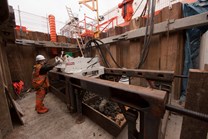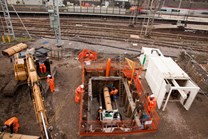Bletchley Remodelling, West Coast Main Line
This wasn't our first foray on this particular stretch of the railway infrastructure as we completed thirteen successful crossings in 2004. We first started this project with Clough Smith Rail, then following their unfortunate demise, we were adopted by Buckingham Group.
Under track crossings (UTX 'S) can always be a little awkward, especially when the launch shaft is in a green zone working area and the exit shaft is in red zone working. Traditional Guided Auger Boring (GAB) & Micro Tunnelling requires access at both launch and reception shafts whereas our ‘single axis’ system doesn't. This technology eradicates the requirement for expensive shafts, lifting, dewatering and attendances that would usually be required on the reception side during a standard GAB process.
We were first approached about this project in early 2012. Once we explained that our approach would be different from the norm, the client was hooked.
The first UTX was straight across the west coast main line, just north of Bletchley station. This was executed from a 6.0 metre x 3.0 metre shaft located in an area that used to be a cattle loading platform. This enabled us to use 3 metre steel cases and install a 610mm steel sleeve some 65 metres. The ground formation consisted of stiff clays and gravel lenses; our BPU800 made light work of this and the installation took five days including mobilization and demobilization.
After completing the steel sleeve installation, we returned to site after the reception chamber was installed. We then supplied, butt-fused and installed 4 x 160mm PE ducts and 8 x110mm PE ducts.
UTX two was situated south of Bletchley station in a tarmac and cement batching yard belonging Cemex Aggregates. Due to the constraints of the work area, this crossing was executed from a smaller shaft (4.0 metres x 3.0 metres) and the 610mm steel cases were installed in 1 metre lengths up to a distance of 51 metres.
This particular location is where our client saw a significant cost saving by utilising our ‘single axis’ system. This because the postion of the exit shaft was right next to the West Coast main line, meaning red zone, possession and night-time working would be required for all exit shaft works.
The ground formation at this location was slightly different from the last location, it was wet sticky clay with occasional gravel inclusions.






